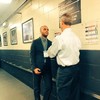Photo by Ken Blaze - USA TODAY Sports
Even before Gordon Hayward suffered one of the more gruesome on-court injuries in recent memory, the Boston Celtics were a long-shot to win the 2018 NBA championship. But that doesn't mean expectations weren't high, or they weren't one of the league's more talented teams heading into a brand new season.Part of the intrigue would be watching how a multi-dimensional star like Hayward fits into Brad Stevens' offense beside Kyrie Irving, Al Horford, and a young, athletic supporting cast. Hayward's injury is a fatal blow to their title chances, which were already fleeting—and it also has a meaningful domino effect on how the roster actually functions. Marcus Smart, Jayson Tatum, Terry Rozier, Jaylen Brown, and Marcus Morris will be called on to initiate more offense than before, while the team's two aforementioned All-Star-caliber players will have to increase their scoring output and playmaking responsibilities.Horford is a rock who should take everything in stride. The real question then, becomes how Hayward's injury impacts Irving on a nightly basis.On Tuesday, Boston's new Big Three only needed a few minutes to display how dangerous and promising their collaboration could be. The scene was set a few possessions into the first quarter: Irving ran a right-side pick-and-roll with Horford, causing Kevin Love to slide up and trap the ball. He then reversed it back to a popping Horford, forcing the Cleveland defense to make precise rotations.LeBron James completely ignored Jaylen Brown in the weakside corner and sprinted to smother Horford at the top of the key. Not even one second later, Hayward cut towards the free-throw line from the opposite wing. Horford hit him on the move, and the one-time All-Star calmly stopped on a dime to nail a mid-range jumper over Jae Crowder.It wasn't the most aesthetically beautiful or even effective possession ever seen (two-point shots outside the restricted area rarely are), but it showed how top-tier offensive talent can make even the most committed defense work hard.The possession also showed how Hayward could simplify Irving's duty, and how, over time, opposing teams would be forced to pick their poison. Hayward's absence presents Boston with void nobody on the roster can fill. Brown and Tatum may be budding cornerstones, but they're nowhere near Hayward. They can't space the floor as well as he does, and don't yet understand angles, rhythms, and all the subtle nuances that can't be learned without experience.Irving can still have individual success going one-on-one, but neither he nor the Celtics can be as potent as they want if the ball is routinely in his hands at the start of every play. There's a reason why the Cleveland Cavaliers' offensive rating fell an astonishing 14.4 points per 100 possessions when their All-Star point guard was on the court without LeBron.It's in Boston's best short and long-term interest to instead highlight Irving without reducing activity elsewhere. Having four guys stand around to watch him dance isn't great for anybody's development.Last night, Irving recorded 10 assists with a 43.5 assist percentage—a mark he only reached 18 times since LeBron became a teammate—and that's obviously a good sign. But now that Hayward is gone, the Celtics will need to find more ways to let their best scorer attack without allowing opposing teams sag off everybody else.To do so, Stevens worked Irving off the ball quite a bit. They ran a simple yet crippling action from their Horns formation—which starts with two shooters (on this occasion Brown and Tatum) spotting up in the corners while two bodies position themselves at the elbows—where a ball-handler enters the ball to whoever's opposite Irving, then screens away on his man.Few players alive are able to make shots without any advantage as consistently as Irving; this sequence gives him a devastating step on his man that makes slowing the Celtics down almost unfair. He flies up to gather the hand-off as his initial defender gets smacked by a second screen. If there's enough room, the career 38.3 percent outside shooter can rise up for an open three.If the big recognizes what's happening and quickly steps up to contest the shot, he can either roast his new, slower defender on a switch, or hit Horford, Baynes (or whoever set the second screen) on a short roll and gut the other team with a 4-on-3 advantage.It's a crushing sequence that puts one of the world's best shooters in a fantastic position to stab the other team, without having to do a ton of leg work on his own to get there. According to Synergy Sports, Irving finished six possessions from a hand-off in his Celtics debut. He averaged 1.3 such plays per game on the Cavs last season—and 5.1 isolations. (Irving only isolated three times last night.)Additionally, Boston ran their most potent weapon off stagger screens to force switches and isolate him on more delayed defenders like Tristan Thompson. They also unleashed him in the same screen-the-screener sets that the Golden State Warriors use with Steph Curry. The gravity Irving demands in these situations will over time cause opposing defenses to shift their entire focus to stopping him—which opens things up for Tatum, Brown, Smart, and everybody else.In the meantime, the more catch-and-shoot threes Irving gets, the better. Guarding him when he has the ball right in front of you—and everyone in the gym knows what he's about to do—is already a Herculean task. To ask defenses to slow him down when engaged against a confusing stream of direct handoffs, misdirections, and off-ball screens, is impossible. Even if Hayward won't be around to help.
Advertisement
Advertisement
